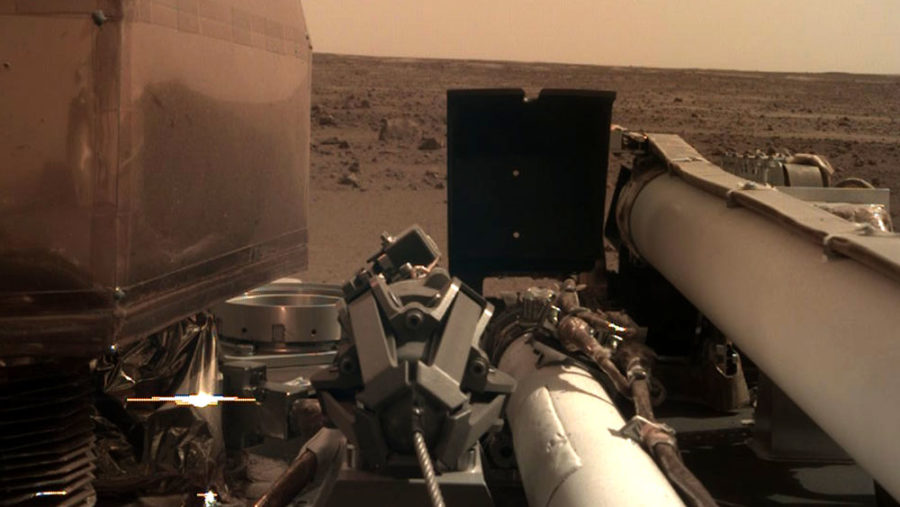Our InSight into Mars
On Nov 26, Nasa’s Jet Propulsion Laboratory successfully landed their InSight lander at Elysium Planitia, Mars.
On May 5, 2018 at 4:05 a.m. PT or 7:05 a.m. ET, InSight launched atop an Atlas V-401 rocket from Launch Complex-3 at Vandenberg Air Force Base in California. The launch of InSight was the first interplanetary launch from the west coast, most interplanetary launches usually launch from Cape Canaveral, Fla.
After launching aboard an Atlas-401 rocket, InSight began a 301 million mile voyage to Mars which lasted about six months. The mission for InSight didn’t really begin until it landed at Elysium Planitia. But, InSight was not alone, two CubeSats which were meant to relay communications from InSight to Earth during Entry Descent and Landing or EDL. Usually satellites which orbit Mars are solely responsible for communications during EDL, but the CubeSats helped the controllers get data quicker.
The CubeSats were named MarCO-A and MarCO-B as part of their mission called Mars Cube One. The CubeSats were only about the size of a briefcase. Both MarCOs are now the first interplanetary CubeSats ever launched. Since their jobs are done, they will fly into space father and farther away and their signals will get weaker.
InSight began its Entry Descent and Landing (EDL) phase when InSight was 80 miles above the Martian surface and entering the Martian atmosphere. After reentry, the spacecraft deployed a supersonic parachute. Then, the spacecraft jettisoned its heat shield and deployed its three landing legs. Next, InSight jettisoned from its backshell and began its powered descent. InSight’s 12 landing engines helped it descend smoothly. At exactly 11:52:59 a.m. PT or 2:52:59 p.m. ET, JPL’s mission control erupted into cheer and applause when an engineer called out the phrase “touchdown confirmed,” InSight had landed on Mars at Elysium Planitia.
Engineers at JPL got their first photo from InSight at Elysium Planitia 4½ minutes after landing thanks to one of the CubeSats. The landing site was chosen because Elysium Planitia is flat and InSight required a flat site to land on its three landing legs.
Seven hours after touchdown, the two ever so critical solar arrays were deployed. It is believed that InSight landed slightly off target, but still in the planned landing ellipse. However, InSight got lucky by landing in a filled-in crater amid a field of rocks. However, more information will be released soon.
InSight is not a rover, it is a lander since its mission requires it to be stationary. InSight is short for Interior exploration using Seismic Investigations, Geodesy, and Heat Transport. The spacecraft costed $1 billion dollars in international funds to build through partnerships. InSight comprises of a seismometer (SEIS), a heat probe (HP3) to take Mars’s internal temperature, a robotic arm, temperature and wind sensors, and a radio science experiment (RISE) which will measure the wobble of Mars’s North Pole, and two solar arrays. The seismometer on the lander is one of the main focuses of the mission. The device is meant to detect marsquakes.
Both the seismometer and the heat probe are required to be placed onto the Martian surface before they can start collecting scientific data. To get both probes on the Martian surface, both will be moved using InSight’s robotic arm. It will be many months till all of InSight’s experiments start operating and discovering new science. However, in the few sols InSight has been on Mars (six sols at the time publishing) InSight has moved its robotic arm and grapple. A Sol is a Martian day which lasts for 24 hours and 39½ minutes.
InSight is heavily based on the design from the Mars Phoenix lander which landed on Mars in 2008. The spacecraft landed near Mar’s north pole and only lasted for one Martian year until winter. InSight is much heavier than Phoenix was due to more experiments on board.
InSight is now the eighth spacecraft that JPL has landed on the surface of Mars successfully (JPL lost one). Both the European Space Agency (failed) and the former Soviet Union have attempted to land spacecraft on Mars. The first spacecraft to make a soft landing on Mars was the Soviet Mars-3 lander on Dec 2, 1971. However, the Mars-3 spacecraft failed soon after landing due to a global Martian duststorm. JPL landed their first lander, Viking 1 on Mars on July 20, 1976.
InSight now joins JPL’s fleet of dead and active spacecraft both orbiting and on the surface of Mars. Currently, JPL’s Curiosity rover, which is part of the Mars Science Laboratory mission and the Opportunity rover, also known as MER-1. Opportunity has been on mars for more than 5,277 Sols (5,422 earth days) even though it was designed only to last 90 Sols (92.5 earth days) when it landed on Mars in 2004.
However, due to a recent global duststorm, Opportunity has not communicated back to Earth and may be dead. But, Curiosity has been alive and well roving the Martian surface like it has since landing in Gale Crater on Aug 6, 2012. The Mars 2020 rover, which is based upon Curiosity will launch for Jezero Crater on Mars in July of 2020 and is currently scheduled to land on Feb 18, 2021.
InSights’s mission is supposed to last for two years which is one Martian year. Even though InSight is near the equator (which will help it get more sunlight for the solar arrays), the spacecraft won’t be able to operate forever. Near the end of its service life, the spacecraft will slowly loose solar power due to dust slowly accumulating on the solar arrays, blocking out sunlight.


